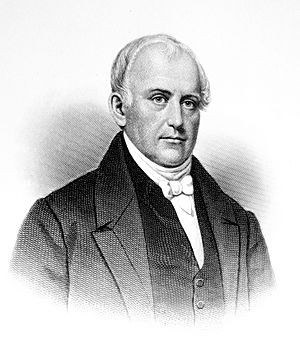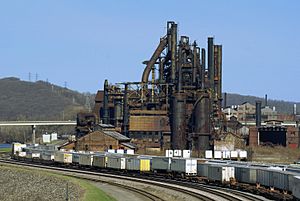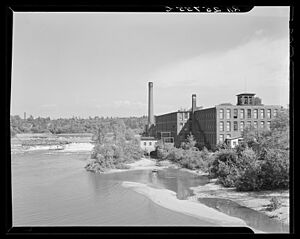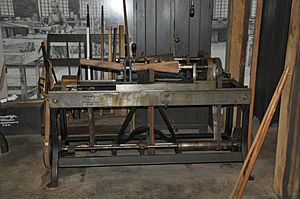Industrial Revolution in the United States facts for kids
The Industrial Revolution was a big change in how things were made in the United States. It happened mostly in the late 1700s and 1800s. Before this, most people worked on farms or made things by hand. But during the Industrial Revolution, the country started using more machines and factories. This led to many new inventions and much faster ways of making goods. It helped the U.S. economy grow a lot!
This revolution happened in two main parts. The First Industrial Revolution was from the late 1700s to the mid-1800s. The Second Industrial Revolution came after the American Civil War. Key people and inventions in the first part included Samuel Slater bringing textile factory ideas from Britain, Eli Whitney inventing the cotton gin, and Éleuthère Irénée du Pont improving gunpowder. Important projects like the Erie Canal also played a big role.
Contents
How America Became Industrialized



Early Changes in the 1700s
In the late 1700s, countries in Europe like Britain were building many factories. But the United States was still mostly a farming country. Most of its industries were small, like mills that ground grain or cut wood. As the U.S. grew, people needed better ways to move goods. This led to building canals and railroads.
New technologies were needed to help the country grow. This sparked the Industrial Revolution in America. Business owners and inventors worked to create better machines and ways of making things. Some of these new ideas came from British designs. Ambitious British inventors brought these ideas to America to start their own companies.
Many early industrial changes in the U.S. happened in the Lehigh Valley in eastern Pennsylvania. This area became a leader in making iron ore, steel, and textile products.
Samuel Slater and Textiles
One important person was Samuel Slater. He is known for starting the textiles industry in the U.S. Slater learned about textile machines in England. It was illegal to share these designs outside of England. So, he memorized the plans and moved to New York City.
Moses Brown, a rich businessman from Rhode Island, hired Slater. Slater promised to build British-style textile machines. With Brown's help, the first successful water-powered textile mill opened in 1793. By 1800, many others copied Slater's mill. He became very wealthy. President Andrew Jackson even called him the "Father of the American Industrial Revolution." But some in Britain called him "Slater the Traitor" for sharing their secrets.
Eli Whitney and the Cotton Gin
In 1794, Eli Whitney invented the cotton gin. This machine made it much faster to clean cotton. Before the gin, it took a long time to separate cotton fibers from their seeds by hand. The cotton gin made cotton farming much more profitable.
By the early 1800s, cotton became a huge crop in the southern U.S. By the mid-1800s, southern farms supplied 75% of the world's cotton. Whitney's invention was a big surprise. It changed cotton production in a way no one expected.
The du Pont Family and Gunpowder
The du Pont family came to the United States from France. They knew a lot about chemistry and making gunpowder. E.I. du Pont noticed that American gunpowder was not very good. So, in 1802, he opened the Eleutherian Mills gunpowder factory. It was on Brandywine Creek.
The mill was also home to du Pont's family. Employees lived nearby. The company grew quickly. By the mid-1800s, it was the biggest supplier of gunpowder to the U.S. military.
Robert Fulton and Steamboats
In the late 1700s, Robert Fulton from Pennsylvania had ideas for boats powered by steam. He had learned a lot about technology in France and Britain. Fulton came back to the U.S. and worked with Robert Livingston. Together, they launched the first successful steamboat that carried people and goods. It traveled between New York City and Albany.
Fulton also built a strong steamboat for the Ohio and Mississippi rivers. He helped plan the Erie Canal. He even designed an early working submarine called the Nautilus.
Building the Erie Canal
The idea for the Erie Canal came up in the 1780s. Construction finally began in 1817. The original canal was about 363 miles long. It had 34 locks and ran from Albany to Buffalo. Before the canal, moving heavy goods was hard. People used pack animals, and there were no railroads. Water was the cheapest way to ship large items.
The Erie Canal made transport much faster than using wagons. It also cut shipping costs by about 95%. This canal gave New York City's port a big advantage. It helped the population grow in New York state and areas further west.
Laws That Helped Industry Grow
The U.S. government passed laws to help American businesses. For example, the Embargo Act of 1807 stopped imports from Britain. This law helped new American industries grow, especially textile factories. It made the U.S. less dependent on goods made in other countries.
Work and Money During the Revolution
The First Industrial Revolution changed how people worked. It shifted from people making goods at home to working in factories. Even though many Americans still farmed, the government tried to help industry grow.
Alexander Hamilton suggested ideas called the "American School." He believed in high taxes on imported goods to protect U.S. industries. The Whig Party supported this idea in the early 1800s. They backed Henry Clay's "American System." This plan suggested not only tariffs but also building canals and roads. These would help move factory-made goods across the country.
Like in Britain, the textile industry was very important in the U.S. during this time. Early textile factories were built near rivers. They used the flowing water to power their machines. This is why many early factories were in the Northeastern United States.
To help businesses get money, Congress created the Bank of the United States in 1791. It gave loans to business owners. However, some people, like the Jeffersonians, thought this bank gave the federal government too much power. So, when its charter ended in 1811, Congress did not renew it.
States then started their own banks. By 1816, there were 246 state banks. These banks helped fund projects like the Erie Canal. This support helped the economy grow.
Impact of the Industrial Revolution

The Industrial Revolution completely changed the U.S. economy. It prepared the country to become a leader in technology and growth during the Second Industrial Revolution. It also helped solve the problem of not having enough workers.
Better transportation, like the Wilderness Road, the Erie Canal, steamboats, and railroads, connected different parts of the country. This led to more people moving to cities. Cities like New York City and Chicago grew. This meant more workers were available for factories. Also, moving resources and goods became much faster. This made trade more efficient and helped the U.S. grow even more.
Interchangeable Parts and Assembly Lines
New ways of making interchangeable parts were developed in the U.S. This meant that if a part broke, you could easily replace it with an identical new one. This made it easier and faster to put together and fix things like firearms. By the time of the Civil War, rifles were made with interchangeable parts. Later, more complex items like sewing machines and typewriters also used them.
In 1798, Eli Whitney got a government contract to make 10,000 muskets. He was supposed to do it in less than two years. By 1801, he hadn't made any. So, he went to Washington to explain. There, he showed Congress how he could build muskets from parts chosen randomly. Even though this demonstration was later found to be fake, it made the idea of interchangeable parts very popular. Whitney continued to use this idea. It allowed less skilled workers to make and fix weapons quickly and cheaply.
Another important inventor was Thomas Blanchard. In 1819, he invented the Blanchard lathe. This machine could make many identical copies of wooden gun stocks.
Interchangeable parts made the assembly line possible. Assembly lines made production faster. They also meant that workers didn't need to be highly skilled. Each worker would do just one simple, repeated step instead of making the whole product.
Changes for Workers
The First Industrial Revolution had a big effect on workers. Companies like the Boston Associates hired thousands of young women from farms in New England to work in textile mills. These girls often earned less than men. But the work and pay gave them a sense of independence they didn't have on the farm.
This period also marked the start of wage labor in the United States. As more people worked for wages over the next century, it greatly changed American society.

